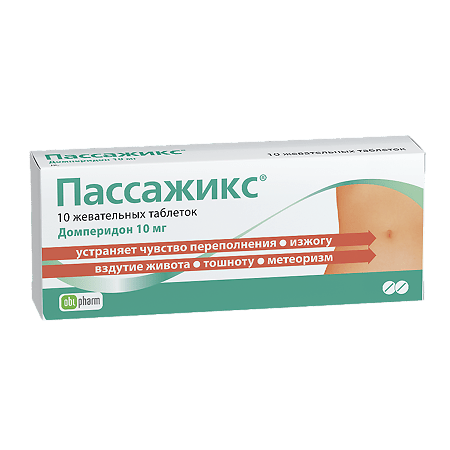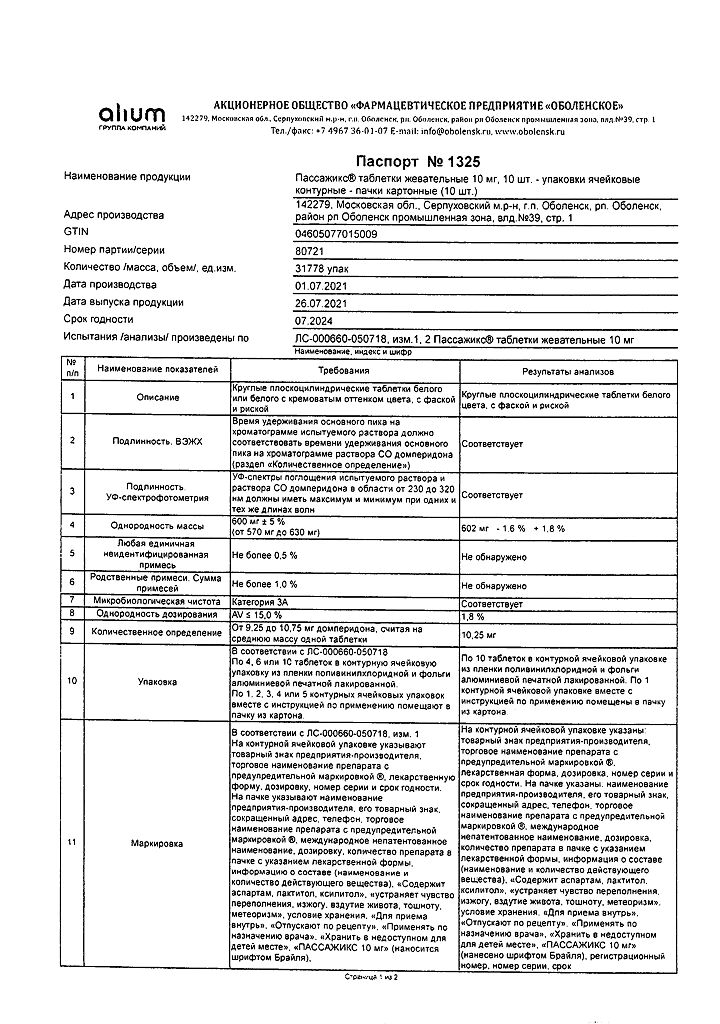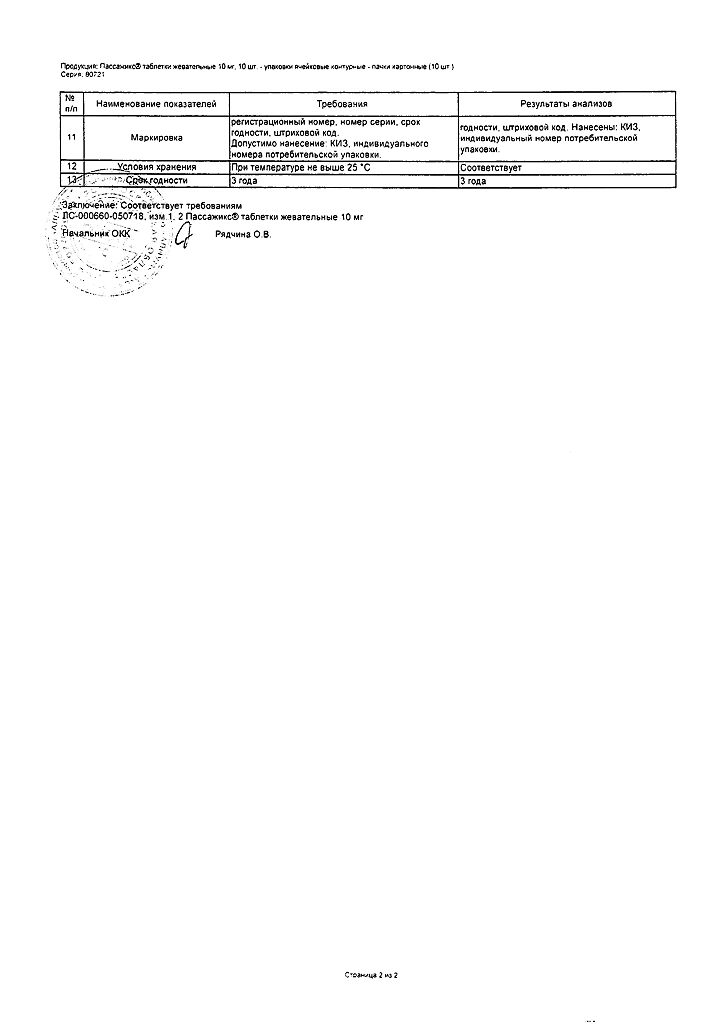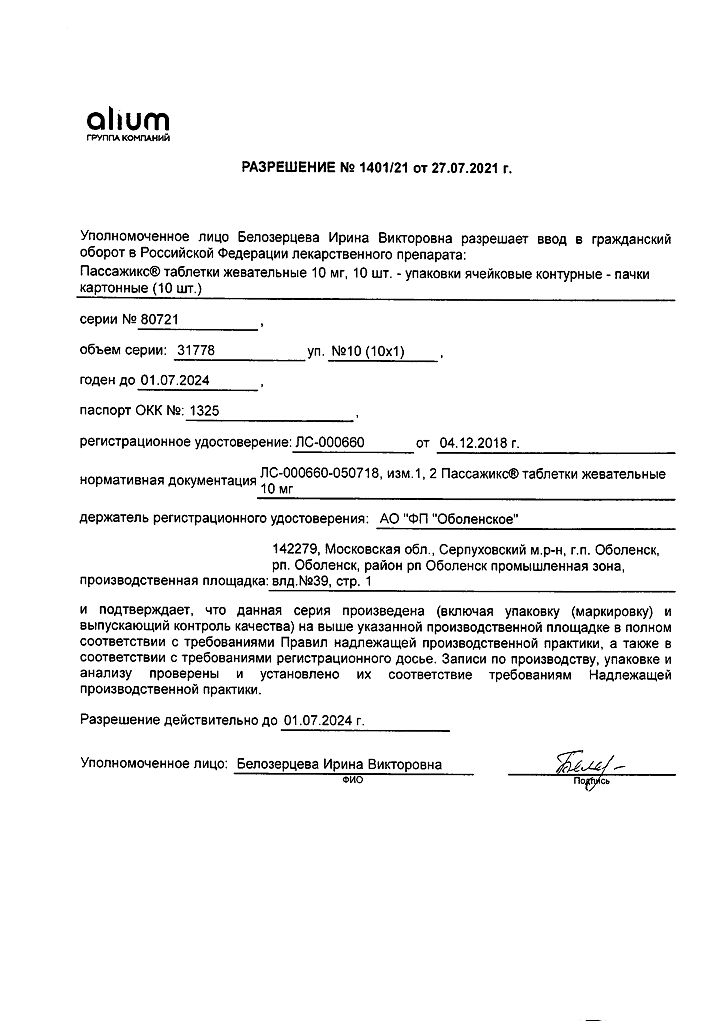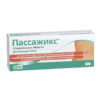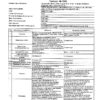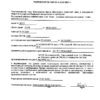No products in the cart.
Passazhix, 10 mg 10 pcs
€6.87 €6.01
Description
Passazhix is an antiemetic.
Pharmacodynamics
Lengthens the duration of peristaltic contraction of the antral stomach and duodenum, accelerates gastric emptying in case this process is delayed, increases lower esophageal sphincter tone, eliminates development of nausea and vomiting.
Domperidone poorly penetrates through the GEB (so its use is rarely accompanied by extrapyramidal side effects, especially in adults), but it stimulates prolactin release from the pituitary gland. Its antiemetic effect may be due to a combination of peripheral (gastrokinetic) action and antagonism to dopamine receptors in the trigger chemoreceptor zone of the medulla oblongata. Domperidone has no effect on gastric secretion.
Pharmacokinetics
Domperidone is rapidly absorbed after oral administration.
It has low bioavailability (about 15%). Decreasing the acidity of gastric juice reduces the absorption of domperidone. Cmax in plasma is reached after 1 hour.
Domperidone is widely distributed in various tissues, in the brain tissue its concentration is low. Binding to plasma proteins is 91-93%.
It is subjected to intensive metabolism in the intestinal wall and the liver.
It is excreted by the intestine (66%) and the kidneys (33%), respectively 10 and 1% of the dose is excreted unchanged. T1/2 is 7-9 hours; in case of marked renal insufficiency it is prolonged.
Indications
Indications
vomiting and nausea of various origins (including against the background of functional and organic diseases, infections, toxemia, radiation therapy, diet disorders;
medicinal origin – taking morphine, apomorphine, levodopa and bromocriptine;
when conducting endoscopic and radiopaque (the need to accelerate peristalsis) studies of the gastrointestinal tract;
hiccups, gastrointestinal atony (including postoperative);
dyspeptic disorders due to delayed gastric emptying, gastroesophageal reflux and esophagitis (a feeling of fullness in the epigastrium, a feeling of bloating, flatulence, gastralgia, heartburn, belching with or without reflux of gastric contents into the oral cavity).
Pharmacological effect
Pharmacological effect
Passazhix is an antiemetic.
Pharmacodynamics
Increases the duration of peristaltic contractions of the antrum of the stomach and duodenum, accelerates gastric emptying if this process slows down, increases the tone of the lower esophageal sphincter, and eliminates the development of nausea and vomiting.
Domperidone poorly penetrates the blood-brain barrier (therefore, its use is rarely accompanied by extrapyramidal side effects, especially in adults), but it stimulates the release of prolactin from the pituitary gland. Its antiemetic effect may be due to a combination of peripheral (gastrokinetic) action and antagonism of dopamine receptors in the chemoreceptor trigger zone of the medulla oblongata. Domperidone has no effect on gastric secretion.
Pharmacokinetics
After taking the drug orally, domperidone is rapidly absorbed.
It has low bioavailability (about 15%). Reducing the acidity of gastric juice reduces the absorption of domperidone. Cmax in plasma is reached after 1 hour.
Domperidone is widely distributed in various tissues; its concentration in brain tissue is low. Plasma protein binding is 91–93%.
Subject to intensive metabolism in the intestinal wall and liver.
Excreted through the intestines (66%) and kidneys (33%), respectively 10 and 1% of the dose are excreted unchanged. T1/2 is 7–9 hours, with severe renal failure it is prolonged.
Special instructions
Special instructions
When using Passazhix in combination with antacid or antisecretory (m-anticholinergics, H2-histamine receptor blockers, proton pump inhibitors) drugs, the latter should be taken after and not before meals, i.e. they should not be taken at the same time as Passagix.
Use for liver diseases. Given the metabolism of domperidone in the liver, Passazhix should be administered with caution to patients with liver failure.
Use for kidney diseases. In patients with severe renal failure (serum creatinine >6 mg/100 ml, i.e. >0.6 mmol/l), T1/2 of domperidone increased from 7.4 to 20.8 hours, but plasma concentrations of the drug were lower than in healthy volunteers. Since a very small percentage of the drug is excreted unchanged by the kidneys, single dose adjustment is hardly necessary in patients with renal failure. However, when re-prescribed, the frequency of administration should not exceed 1-2 times a day, depending on the severity of the deficiency; it may also be necessary to reduce the dose. During long-term therapy, patients should be monitored regularly.
Effect on the ability to drive a car or other mechanical means. Domperidone does not affect the ability to drive vehicles and engage in other potentially hazardous activities that require increased concentration and speed of psychomotor reactions.
Active ingredient
Active ingredient
Domperidone
Composition
Composition
Active ingredient:
domperidone 10 mg;
Excipients:
potato starch;
lactose;
colloidal silicon dioxide;
collidon 30;
calcium stearate;
sodium dodecyl sulfate;
hydroxypropylcellulose “Klutsel”;
twin 80;
titanium dioxide
Contraindications
Contraindications
established intolerance to the drug and its components;
prolactin-secreting tumor of the pituitary gland (prolactinoma);
phenylketonuria;
children under 5 years of age and children weighing up to 20 kg.
Passazhix should not be used when stimulation of gastric motility may be dangerous, incl. with gastrointestinal bleeding, mechanical obstruction or perforation.
With caution: renal/liver failure, lactation, pregnancy.
Side Effects
Side Effects
From the digestive system: transient intestinal spasms.
From the side of the central nervous system: extrapyramidal phenomena are observed in children and with increased permeability of the BBB. These phenomena are completely reversible and disappear spontaneously after cessation of treatment.
From the endocrine system: the drug can induce an increase in the concentration of prolactin in plasma, because The pituitary gland is located outside the BBB. In rare cases, this hyperprolactinemia can stimulate the appearance of galactorrhea, gynecomastia and dysmenorrhea.
Allergic reactions: rash, urticaria.
Interaction
Interaction
When used concomitantly, anticholinergic drugs may counteract the effects of domperidone.
When used simultaneously with domperidone, antacids reduce its bioavailability.
Based on in vitro studies, it can be assumed that with simultaneous use with domperidone of drugs that significantly inhibit the CYP3A4 isoenzyme (antifungals of the azole group, antibiotics from the macrolide group, HIV protease inhibitors, the antidepressant nefazodone), an increase in the concentration of domperidone in plasma may be observed.
The drug does not affect the concentrations of paracetamol and digoxin in the blood. It is possible that domperidone may affect the absorption of concomitantly administered orally administered drugs with sustained release of the active substance or enteric-coated drugs.
Overdose
Overdose
Symptoms: drowsiness, disorientation and extrapyramidal reactions, especially in children.
Treatment: in case of overdose, the administration of activated carbon and careful monitoring are recommended.
Anticholinergics, drugs used to treat parkinsonism, or antihistamines may be effective if extrapyramidal reactions occur.
Storage conditions
Storage conditions
In a dry place, protected from light, at a temperature not exceeding 25 °C
Shelf life
Shelf life
2 years
Manufacturer
Manufacturer
Alium JSC, Russia
Additional information
| Shelf life | 2 years |
|---|---|
| Conditions of storage | In a dry, light-protected place at a temperature not exceeding 25 °C |
| Manufacturer | Obolenskoe FP JSC, Russia |
| Medication form | chewable tablets |
| Brand | Obolenskoe FP JSC |
Related products
Buy Passazhix, 10 mg 10 pcs with delivery to USA, UK, Europe and over 120 other countries.

